
The southern frogs form the Leptodactylidae, a name that comes from Greek meaning a bird or other animal having slender toes. They are a diverse family of frogs that most likely diverged from other hyloids during the Cretaceous. The family has undergone major taxonomic revisions in recent years, including the reclassification of the former subfamily Eleutherodactylinae into its own family the Eleutherodactylidae; the Leptodactylidae now number 206 species in 13 genera distributed throughout Mexico, the Caribbean, and Central and South America. The family includes terrestrial, burrowing, aquatic, and arboreal members, inhabiting a wide range of habitats.

Crinia is a genus of frog, native to Australia, and part of the family Myobatrachidae. It consists of small frogs, which are distributed throughout most of Australia, excluding the central arid regions. Many of the species within this genus are non-distinguishable through physical characteristics, and can only be distinguished by their calls.
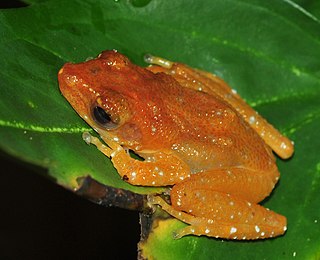
Nyctixalus is a genus of frogs in the family Rhacophoridae. The common name is Indonesian tree frogs. They can be found in the Malay Peninsula, Sumatra, Java, Borneo, the Philippines, and southern Vietnam. Nyctixalus is the sister taxon of Theloderma. It has also been considered subgenus of Theloderma, but the most recent research treat it as a distinct genus.
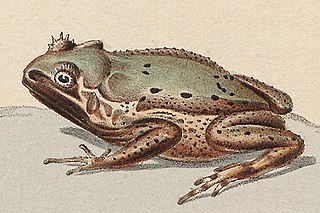
Asterophrys is a genus of microhylid frogs found in New Guinea. Their common name is New Guinea bush frogs, although this name may also specifically refer to Asterophrys turpicola.

Pyxicephalus is a genus of true frogs from Sub-Saharan Africa, commonly referred to as African bull frogs or bull frogs. They are very large to large frogs, with females significantly smaller than males. They may take decades to reach their full size potential and they are some of the longest-living frogs, possibly able to reach ages as high as 45 years.
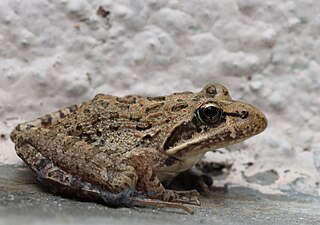
Strongylopus is a genus of pyxicephalid frogs native to Africa. They are found in the area from southwestern South Africa and Namibia to northern Tanzania. Their common name is stream frogs.

Tomopterna is a genus of frogs from sub-Saharan Africa.
Colostethus is a genus of poison dart frogs native to Central and South America, from Panama south to Colombia, Ecuador, and northern Peru. Their common name is rocket frogs, but this name may refer to frogs in other genera and families, following the taxonomic revision of the genus in 2006.
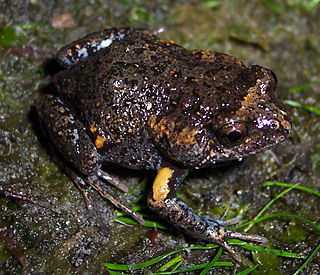
Uperoleia is a genus of frogs in the family Myobatrachidae. They are native to northern and eastern Australia and southern lowlands of New Guinea. These are small squat frogs, more commonly known as "toadlets". They have glandular skin, often with a pair of raised glands behind each eye, or on the flanks.

The raucous toad, also known as Ranger's toad, is a species of toad from Southern Africa.
Pleurodema bibroni is a species of frog in the family Leptodactylidae. Its common name is four-eyed frog, although this name can also refer to the genus Pleurodema in general. The common name refers to two inguinal poison glands that resemble eyes. When threatened, the frog lowers its head and raises its rear. When the frog adopts this posture the poison glands are also raised toward the predator. The predator may also confuse the frog's raised posterior for the head of a larger animal.
Pleurodema borellii is a species of frog in the family Leptodactylidae. It is found in northwestern Argentina and southern Bolivia. The taxonomic status of this species is uncertain, and it may be a junior synonym of Pleurodema cinerea. It is abundant in Argentina, occurring in the Chaco-Yungas transition and montane grasslands on the eastern slopes of the Andes. Reproduction takes place in small permanent and temporary pools where pairs build floating foam nests. It is also found in disturbed habitats, including urban areas. No major threats to this species have been identified.

The Colombian four-eyed frog is a species of frog in the family Leptodactylidae. It is found in an area stretching from Guyana and northern Brazil through Venezuela and Colombia into Panama as well as the Netherlands Antilles.

Pleurodema bufoninum, the large four-eyed frog, is a species of frog in the family Leptodactylidae. It is found in Argentina and Chile. Its natural habitats are subantarctic forests, temperate forests, subantarctic shrubland, temperate shrubland, subtropical or tropical dry shrubland, subantarctic grassland, temperate grassland, intermittent rivers, swamps, intermittent freshwater marshes, arable land, rural gardens, ponds, and open excavations. The common name "four-eyed frog" refers to two inguinal poison glands that resemble eyes. When threatened, the frog lowers its head and raises its rear. When the frog adopts this posture, the poison glands are also raised toward the predator. The predator may also confuse the frog's raised posterior for the head of a larger animal.
Pleurodema cinereum is a species of frog in the family Leptodactylidae. It is found in the Andes in northwestern Argentina, Bolivia, and southeastern Peru. Its common name is Juliaca four-eyed frog, after its type locality, Juliaca. Pleurodema borellii is possibly a junior synonym of this species.
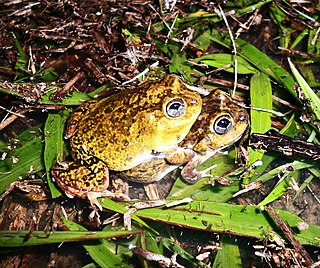
Pleurodema diplolister, the Peters' four-eyed frog, is a species of frog in the family Leptodactylidae. It is endemic to Brazil. Its natural habitats are dry savanna, moist savanna, subtropical or tropical dry shrubland, subtropical or tropical dry lowland grassland, intermittent freshwater marshes, sandy shores, and pastureland. It is threatened by habitat loss. The common name "four-eyed frog" refers to two inguinal poison glands that resemble eyes. When threatened, the frog lowers its head and raises its rear. When the frog adopts this posture, the poison glands are also raised toward the predator. The predator may also confuse the frog's raised posterior for the head of a larger animal.

Hylarana, commonly known as golden-backed frogs, is a genus of true frogs found in tropical Asia. It was formerly considered highly diverse, containing around 84 to 96 valid species, but taxonomic revision resulted in a major change in the contents of the genus, and today it is recognised as containing just four species.
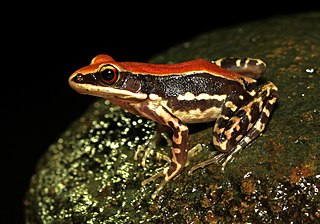
Hydrophylax is a genus of true frogs. They are found in South and Southeast Asia.

The Leiuperinae are a subfamily of frogs in the family Leptodactylidae. Over 90 species are in five genera. The distribution of this subfamily is from southern Mexico to the Central America and much of South America.
Pleurodema cordobae is a species of frog in the family Leptodactylidae. It is endemic to the Sierras de Córdoba of Argentina. This endemic species also resides with the highly similar species, Pleurodema kriegi. P. cordobae exhibits particular characteristics that differentiate it from other frogs in the Pleurodema genus, including the fact that the species is octoploid, as compared to the P. kriegi and Pleurodema bibroni, which are tetraploid. P. cordobae inhabits temporary and semi-permanent ponds. As this species is only found in isolated locations such as the Sierra Grande, little is known about its very limited population.













